|
|
Title | Date | Type | Setname |
| 1 |
 |
2013 William F Hoyt Lecture: Neuro-Ophthalmology in Review: Around the Brain with 50 Fellows | 2013-11-19 | Image/MovingImage | ehsl_novel_novel |
| 2 |
 |
A Family | | Image | uu_aah_art |
| 3 |
 |
A new plan of ye great town of Boston in New England in America, with the many additionall [sic] buildings, & new streets, to the year, 1769 | | Image | uu_aah_art |
| 4 |
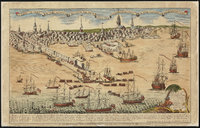 |
A view of part of the town of Boston in New-England and Brittish[sic] ships of war landing their troops! 1768 | | Image | uu_aah_art |
| 5 |
 |
The Black Jacobins: Toussaint L'Ouverture and the San Domingo Revolution | | Image | uu_aah_art |
| 6 |
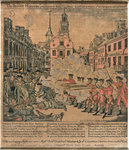 |
The Bloody Massacre Perpetrated in King Street Boston on March 5th 1770 by a Party of ye 29th Regt, 1770-2 | | Image | uu_aah_art |
| 7 |
 |
Boston Massacre, March 5th, 1770 | | Image | uu_aah_art |
| 8 |
 |
Boston, its environs and harbour, with the rebels works raised against that town in 1775 | | Image | uu_aah_art |
| 9 |
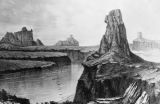 |
Colorado River -- Crossing of the Fathers p.1 | 1871; 1872; 1873; 1874; 1875; 1876; 1877; 1878; 1879 | Image/StillImage | dha_cp |
| 10 |
 |
Colorado River -- Crossing of the Fathers p.10 | 1950; 1951; 1952; 1953; 1954; 1955; 1956; 1957; 1958; 1959; 1960; 1961; 1962; 1963 | Image/StillImage | dha_cp |
| 11 |
 |
Crispus Attucks Monument (also known as Boston Massacre Monument) | | Image | uu_aah_art |
| 12 |
 |
Crispus Attucks Monument (also known as Boston Massacre Monument) | | Image | uu_aah_art |
| 13 |
 |
Crispus Attucks Monument (also known as Boston Massacre Monument) | | Image | uu_aah_art |
| 14 |
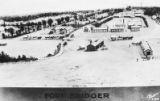 |
Fort Bridger - Wyoming | | Image | ucl_vep |
| 15 |
 |
Gathering in the desert, 1926 [1] | 1926-11-06 | Image | dc_bpc |
| 16 |
 |
Gathering in the desert, 1926 [2] | 1926-11-06 | Image | dc_bpc |
| 17 |
 |
Gathering in the desert, 1926 [3] | 1926-11-06 | Image | dc_bpc |
| 18 |
 |
Gathering in the desert, 1926 [4] | 1926-11-06 | Image | dc_bpc |
| 19 |
 |
Gathering in the desert, 1926 [5] | 1926-11-06 | Image | dc_bpc |
| 20 |
 |
Gathering in the desert, 1926 [6] | 1926-11-06 | Image | dc_bpc |
| 21 |
 |
Gathering in the desert, 1926 [7] | 1926-11-06 | Image | dc_bpc |
| 22 |
 |
Harriet Tubman series, panel 1 | | Image | uu_aah_art |
| 23 |
 |
Harriet Tubman series, panel 10 | | Image | uu_aah_art |
| 24 |
 |
Harriet Tubman series, panel 11 | | Image | uu_aah_art |
| 25 |
 |
Harriet Tubman series, panel 12 | | Image | uu_aah_art |
| 26 |
 |
Harriet Tubman series, panel 13 | | Image | uu_aah_art |
| 27 |
 |
Harriet Tubman series, panel 14 | | Image | uu_aah_art |
| 28 |
 |
Harriet Tubman series, panel 15 | | Image | uu_aah_art |
| 29 |
 |
Harriet Tubman series, panel 16 | | Image | uu_aah_art |
| 30 |
 |
Harriet Tubman series, panel 17 | | Image | uu_aah_art |
| 31 |
 |
Harriet Tubman series, panel 18 | | Image | uu_aah_art |
| 32 |
 |
Harriet Tubman series, panel 19 | | Image | uu_aah_art |
| 33 |
 |
Harriet Tubman series, panel 2 | | Image | uu_aah_art |
| 34 |
 |
Harriet Tubman series, panel 20 | | Image | uu_aah_art |
| 35 |
 |
Harriet Tubman series, panel 21 | | Image | uu_aah_art |
| 36 |
 |
Harriet Tubman series, panel 22 | | Image | uu_aah_art |
| 37 |
 |
Harriet Tubman series, panel 23 | | Image | uu_aah_art |
| 38 |
 |
Harriet Tubman series, panel 24 | | Image | uu_aah_art |
| 39 |
 |
Harriet Tubman series, panel 25 | | Image | uu_aah_art |
| 40 |
 |
Harriet Tubman series, panel 26 | | Image | uu_aah_art |
| 41 |
 |
Harriet Tubman series, panel 27 | | Image | uu_aah_art |
| 42 |
 |
Harriet Tubman series, panel 28 | | Image | uu_aah_art |
| 43 |
 |
Harriet Tubman series, panel 29 | | Image | uu_aah_art |
| 44 |
 |
Harriet Tubman series, panel 3 | | Image | uu_aah_art |
| 45 |
 |
Harriet Tubman series, panel 30 | | Image | uu_aah_art |
| 46 |
 |
Harriet Tubman series, panel 31 | | Image | uu_aah_art |
| 47 |
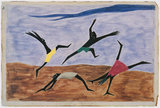 |
Harriet Tubman series, panel 4 | | Image | uu_aah_art |
| 48 |
 |
Harriet Tubman series, panel 5 | | Image | uu_aah_art |
| 49 |
 |
Harriet Tubman series, panel 6 | | Image | uu_aah_art |
| 50 |
 |
Harriet Tubman series, panel 7 | | Image | uu_aah_art |
| 51 |
 |
Harriet Tubman series, panel 8 | | Image | uu_aah_art |
| 52 |
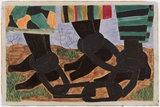 |
Harriet Tubman series, panel 9 | | Image | uu_aah_art |
| 53 |
 |
Interview with Fred Conetah | 1969 | Sound | uaida_main |
| 54 |
 |
Lettres et entretiens sur la danse ancienne, moderne, religieuse, civile, et théâtrale | 1824 | Text | uum_rbc |
| 55 |
 |
The Life of Toussaint L'Ouverture, no. 40: The Declaration of Independence was signed January 1, 1804-Desalines, Clevaux, and Henri Christoph. The people won out | | Image | uu_aah_art |
| 56 |
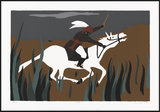 |
The Life of Toussaint L'Ouverture, Opener | | Image | uu_aah_art |
| 57 |
 |
The Life of Toussaint L'Ouverture, Panel no. 5: Slave trade reaches its height in Haiti, 1730 | | Image | uu_aah_art |
| 58 |
 |
The Life of Toussaint L'Ouverture: Flotilla from Toussaint L'Ouverture | | Image | uu_aah_art |
| 59 |
 |
The Life of Toussaint L'Ouverture: General Toussaint L'Ouverture | | Image | uu_aah_art |
| 60 |
 |
The Life of Toussaint L'Ouverture: The Capture | | Image | uu_aah_art |
| 61 |
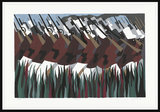 |
The Life of Toussaint L'Ouverture: The March | | Image | uu_aah_art |
| 62 |
 |
The Life of Toussaint L'Ouverture: To Preserve Their Freedom | | Image | uu_aah_art |
| 63 |
 |
The Life of Toussaint L'Ouverture: To Preserve Their Freedom | | Image | uu_aah_art |
| 64 |
 |
Migration Series: Although the Negro was used to lynching, he found this an opportune time for him to leave where one had occurred | | Image | uu_aah_art |
| 65 |
 |
Migration Series: Among one of the last groups to leave the South was the Negro professional who was forced to follow his clientele to make a living | | Image | uu_aah_art |
| 66 |
 |
Migration Series: Among the social conditions that existed which was partly the cause of the migration was the injustice done to the Negroes in the courts | | Image | uu_aah_art |
| 67 |
 |
Migration Series: And people all over the South began to discuss this great movement | | Image | uu_aah_art |
| 68 |
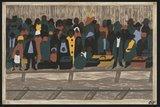 |
Migration Series: And the migrants kept coming | | Image | uu_aah_art |
| 69 |
 |
Migration Series: Another of the social causes of the migrants' leaving was that at times they did not feel safe, or it was not the best thing to be found on the streets late at night. They were arrested on the slightest provocation | | Image | uu_aah_art |
| 70 |
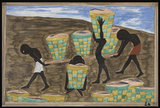 |
Migration Series: Child labor and a lack of education was one of the other reasons for people wishing to leave their homes | | Image | uu_aah_art |
| 71 |
 |
Migration Series: Housing for the Negroes was a very difficult problem | | Image | uu_aah_art |
| 72 |
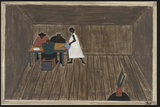 |
Migration Series: In every home people who had not gone North met and tried to decide if they should go North or not | | Image | uu_aah_art |
| 73 |
 |
Migration Series: In many of the communities the Negro press was read continually because of its attitude and its encouragement of the movement | | Image | uu_aah_art |
| 74 |
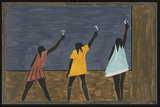 |
Migration Series: In the North the Negro had better educational facilities | | Image | uu_aah_art |
| 75 |
 |
Migration Series: Industries attempted to board their labor in quarters that were oftentimes very unhealthy. Labor camps were numerous | | Image | uu_aah_art |
| 76 |
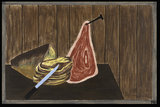 |
Migration Series: Living conditions were better in the North | | Image | uu_aah_art |
| 77 |
 |
Migration Series: One of the largest race riots occurred in East St. Louis | | Image | uu_aah_art |
| 78 |
 |
Migration Series: One of the main forms of social and recreational activities in which the migrants indulged occurred in the church | | Image | uu_aah_art |
| 79 |
 |
Migration Series: Race riots were very numerous all over the North because of the antagonism that was caused between the Negro and white workers. Many of these riots occurred because the Negro was used as a strike breaker in many of the Northern industries | | Image | uu_aah_art |
| 80 |
 |
Migration Series: The labor agent who had been sent South by Northern industry was a very familiar person in the Negro counties | | Image | uu_aah_art |
| 81 |
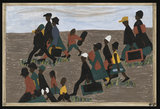 |
Migration Series: The migrants arrived in great numbers | | Image | uu_aah_art |
| 82 |
 |
Migration Series: The migration gained in momentum | | Image | uu_aah_art |
| 83 |
 |
Migration Series: The Negro press was also influential in urging the people to leave the South | | Image | uu_aah_art |
| 84 |
 |
Migration Series: The Negro was the largest source of labor to be found after all others had been exhausted | | Image | uu_aah_art |
| 85 |
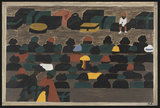 |
Migration Series: The railroad stations in the South were crowded with people leaving for the North | | Image | uu_aah_art |
| 86 |
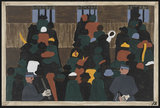 |
Migration Series: The railroad stations were at times so over-packed with people leaving that special guards had to be called in to keep order | | Image | uu_aah_art |
| 87 |
 |
Migration Series: The trains were packed continually with migrants | | Image | uu_aah_art |
| 88 |
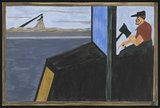 |
Migration Series: The World War had caused a great shortage in Northern industry and also citizens of foreign countries were returning home | | Image | uu_aah_art |
| 89 |
 |
Migration Series: They also made it very difficult for migrants leaving the South. They often went to railroad stations and arrested the Negroes wholesale, which in turn made them miss their train | | Image | uu_aah_art |
| 90 |
 |
Migration Series: They also worked in large numbers on the railroad | | Image | uu_aah_art |
| 91 |
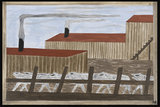 |
Migration Series: They arrived in great numbers into Chicago, the gateway of the West | | Image | uu_aah_art |
| 92 |
 |
Migration Series: They did not always leave because they were promised work in the North. Many of them left because of Southern conditions,; one of them being great floods that ruined the crops, and therefore they were unable to make a living where they were | | Image | uu_aah_art |
| 93 |
 |
Migration Series: They were very poor | | Image | uu_aah_art |
| 94 |
 |
Photograph of the University of Utah Genetics Laboratory | | Image | ir_eua |
| 95 |
 |
Photograph of the University of Utah Genetics Laboratory | | Image | ir_eua |
| 96 |
 |
Research Reproducibility 2016 - Group Photo - 2 | 2016 | Image | ehsl_rr |
| 97 |
 |
Research Reproducibility 2016 - Audience Photo | 2016 | Image | ehsl_rr |
| 98 |
 |
Research Reproducibility 2016 - D. Moher Photo | 2016 | Image | ehsl_rr |
| 99 |
 |
Research Reproducibility 2016 - Group Photo - 1 | 2016 | Image | ehsl_rr |
| 100 |
 |
Research Reproducibility 2016 - H. Bastian Award Photo - 1 | 2016 | Image | ehsl_rr |